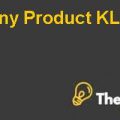Problem Statement:
To improve performance and aggressive competition, how will the management of Gemini Electronics manage its product diversification with the latest technology to compete with its rivals and how will the company manage its funding to acquire new companies for cost effective solutions?
Apparent Issues:
Manufacturing businesses are facing many problems which consist of the economic instability and environmental dynamics. However, the major issues faced by Gemini are related to the business environment of the company. It includes the global recession and change in economic infrastructure and environment along with the aggressive competition in the electronics market. Overseas competitors have given a tough time to Gemini Electronics which results in the major issue for the company. Moreover, the decrease in consumer spending on Gemini’s products due to inflation has affected the business,due to the recession and unstable growth in the US economy.
The tough competition faced by Gemini Electronics was from its overseas competitors who made it difficult for the company to retain its current market share of 35% in the US market. They were using aggressive strategy by reducing the prices of their products to capture more and more customers and improve their market share which made it difficult for the Gemini Management to cut its pricing and match the prices of competitors to remain the market leader. This drastically reduced the profit margin of Gemini Electronics because ithad to sell itsPlasma TVs at relatively lower prices due to the price reduction by its overseas competitors Sony and Samsung.
Current Financial Situation:
The current situation of Gemini Electronics is evaluated by analyzing its financial statements, mainly the income statement and the balance sheet of last 5 years from year 2005 to 2009. Performance is evaluated by using financial tools, such as ratio analysis and more specifically through the Leverage, DuPontanalysis, profitability, liquidity, growth and efficiency ratios.The results are evaluated below:
Profitability Ratios
| Profitability Ratios | ||||||
| Types of Ratios | Formulas | 2005 | 2006 | 2007 | 2008 | 2009 |
| Gross Margin Ratio | Gross Profit/ Net Sales | 38% | 42% | 42% | 35% | 34% |
| Net profit Margin | Net Profit/ Net Sales | 8.59% | 10.25% | 8.32% | 7.01% | 5.70% |
| Return on Assets | Net Income/ Average Total Assets | 8.84% | 12.65% | 10.31% | 10.25% | 7.83% |
| Return on Equity | Net Income/ Average Shareholder's Equity | 23.85% | 41.85% | 35.22% | 29.41% | 21.17% |
The profitability ratios show certain volatility in the last five years’ data. If we look at the Gross margin ratio, it was following an upward trend because of the increasing sales which resulted in the downward trend from year 2008 and 2009 because the company had to reduce its selling prices to compete with its overseas rivals Sony and Samsung. It was above the industry average of 38% in the year 2006 and 2007, but it is below industry average in year 2008 and 2009.
Moreover, the company’s net profit margin was the highest in theyear 2006 because it generated higher revenues and there was not asharp increase in its expenditures. The situation became worst in the later years as there was a reduction in gross profits, and it was followed by the higher selling and administrative expenses along with the high expenditures on research and development to diversify its product line with the latest technology and remain intact in the market by competing with its rivals.......................
This is just a sample partial work. Please place the order on the website to get your own originally done case solution.













